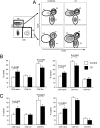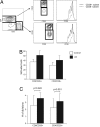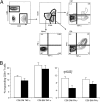Delay of T cell senescence by caloric restriction in aged long-lived nonhuman primates
- PMID: 17159149
- PMCID: PMC1748246
- DOI: 10.1073/pnas.0606661103
Delay of T cell senescence by caloric restriction in aged long-lived nonhuman primates
Abstract
Caloric restriction (CR) has long been known to increase median and maximal lifespans and to decreases mortality and morbidity in short-lived animal models, likely by altering fundamental biological processes that regulate aging and longevity. In rodents, CR was reported to delay the aging of the immune system (immune senescence), which is believed to be largely responsible for a dramatic increase in age-related susceptibility to infectious diseases. However, it is unclear whether CR can exert similar effects in long-lived organisms. Previous studies involving 2- to 4-year CR treatment of long-lived primates failed to find a CR effect or reported effects on the immune system opposite to those seen in CR-treated rodents. Here we show that long-term CR delays the adverse effects of aging on nonhuman primate T cells. CR effected a marked improvement in the maintenance and/or production of naïve T cells and the consequent preservation of T cell receptor repertoire diversity. Furthermore, CR also improved T cell function and reduced production of inflammatory cytokines by memory T cells. Our results provide evidence that CR can delay immune senescence in nonhuman primates, potentially contributing to an extended lifespan by reducing susceptibility to infectious disease.
Conflict of interest statement
The authors declare no conflict of interest.
Figures




References
-
- McCay CM, Crowell MF, Maynard LA. Nutrition. 1989;5:155–171. discussion 172. - PubMed
-
- Masoro EJ. Mech Ageing Dev. 2005;126:913–922. - PubMed
-
- Heilbronn LK, Ravussin E. Am J Clin Nutr. 2003;78:361–369. - PubMed
-
- Hursting SD, Lavigne JA, Berrigan D, Donehower LA, Davis BJ, Phang JM, Barrett JC, Perkins SN. J Nutr. 2004;134:2482S–2486S. - PubMed
-
- Guarente L, Picard F. Cell. 2005;120:473–482. - PubMed
Publication types
MeSH terms
Substances
Grants and funding
LinkOut - more resources
Full Text Sources
Other Literature Sources

